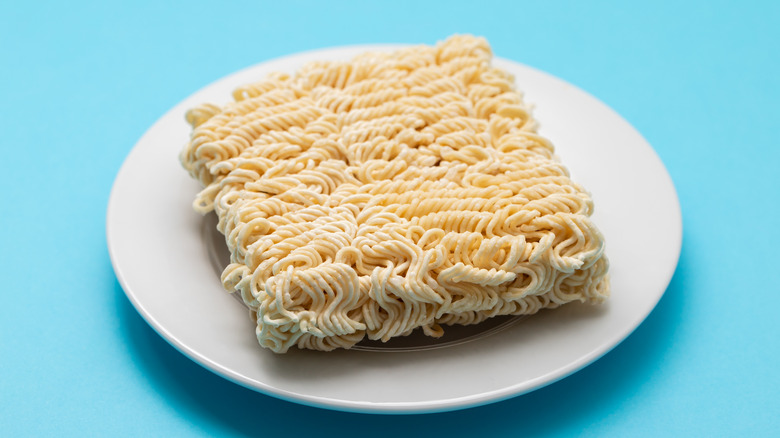Why Instant Ramen Noodles Are Usually Squiggly
There are some things in life which need answers for them to make sense. For instance, the difference between pasta and noodles. One is typically straight, while the other is usually squiggly. The former makes sense from a culinary perspective since it's easier to produce straight pasta from extruders. On the other hand, the quirky form of noodles, though an obvious design choice, can only be understood from a manufacturer's perspective.
According to Dongfang Naomu, a Chinese manufacturer of machinery used in the production of instant noodles, there are practical and mechanical reasons for the wavy shape of noodles. The most obvious is to maximize the space inside the packaging. Unlike straight noodles, squiggly noodles can be compressed into tighter blocks, making it easier for manufacturers to fit more noodles into smaller packets, thus reducing packaging costs. The squiggly shape also makes the drying process faster, since there are gaps in between the strands. Additionally, since instant ramen noodles get deep-fried during production, they become brittle. By molding them into wavy strands, they become more resistant to breakage during packaging and transport.
Aside from these mechanical advantages, squiggly noodles are more convenient for cooking, as the curls prevent the strands from sticking together and create space for water to circulate more easily during boiling. When eating, their wavy form allows them to hold onto sauce or soup well and cling to chopsticks and forks easily.
The origins of squiggly instant ramen noodles
The term "squiggly noodles" gained traction fairly recently thanks to viral brands like A-Sha and Fly By Jing as well as K-dramas that feature Korea's famous comfort food, ramyeon, and chapagetti (a variation on instant noodles), but the roots of the wavy noodle shape go back decades and span across Asian countries, most especially Taiwan and Japan. In 1953, Japanese businessman Yoshio Murata accidentally got the idea for wavy noodles when his noodle-cutting machine malfunctioned and started producing crooked strands instead of straight noodles. This prompted him to develop a new method of cutting noodles. This invention, later patented as the curved noodle manufacturing method, revolutionized noodle-making by speeding up the production of curly strands that had previously been hand-shaped.
While Murata was responsible for the noodles' iconic shape, it was Momofuku Ando, the Taiwanese-born, Japanese founder of Nissin Foods, who invented instant noodles. While staying in post-war Japan, he witnessed food shortages that prompted him to find a way to extend the shelf life of noodles. In 1958, he successfully developed the world's first instant noodle: Chicken Ramen. The technique he used involved flash-frying the noodles to prolong their shelf life and preserve their wavy shape.
So, while modern brands like A-Sha popularized the term "squiggly" to refer to their "knife-cut" noodles, the idea isn't new. The curly shape of instant ramen originated in East Asia during a tumultuous era that called for practical innovations in food manufacturing, storage, and cooking.

